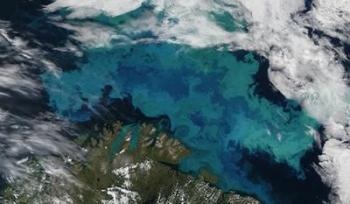Jul 18 2016
A global research team has calculated the advantages and costs of calcification for phytoplankton and analyzed the impact of climate change on their vital role in the ocean’s around the world.
 Satellite image of algae bloom in the Barents Sea: Jeff Schmaltz, MODIS Rapid ResponsTeam, NASA/GSFC
Satellite image of algae bloom in the Barents Sea: Jeff Schmaltz, MODIS Rapid ResponsTeam, NASA/GSFC
Single-celled phytoplankton is of immense significance in the global climate system, marine food webs and marine biogeochemical cycling. One specific group known as coccolithophores envelop themselves with coccoliths, which are referred to as calcium carbonate shields. Some produce coccoliths in the shape of sharp spikes, some cover themselves in an impenetrable coat of coccoliths, some develop funnel-shaped light collectors and some use the coccoliths as parasols against the sun.
This needs an increasing amount of energy and the cost for the artful armor could increase a lot more due to global change. The team used a new model to study the advantages and energetic costs of calcification. The recent issue of the journal Science Advances features the findings of this research that points out that the ecological niche for calcifying algae in the future will become narrower.
In the future ocean, the trade-off between changing ecological and physiological costs of calcification and their benefits will ultimately decide how this important group is affected by ocean acidification and global warming. There are signs that their distribution in the oceans is changing over time. If we understand better the costs and benefits of their distinguishing feature (coccoliths) then this should help us understand why their biogeography is shifting.
Professor Toby Tyrrell, Professor in Earth System Science, University of Southampton
The study's chief author, Dr Fanny Monteiro, lecturer and NERC research fellow from the school of Geographical Sciences at the University of Bristol, added: “Calcification in coccolithophores has high energy demand but brings multiple benefits enabling the currently observed diversity of their ecology and form.”
Researchers from the United States, France, Great Britain and Germany combined results obtained from cell biology studies, modeling, laboratory and field experiments, and evolutionary history studies in order to understand the reason for the elaborate armor and study the extent to which they will bear the consequences of global change.
Presumably, the algae built their calcareous shells as a protection against predators. However, since the different structures had other benefits as well, a variety of forms was developed to make further use of these advantages.
Professor Ulf Riebesell, Marine Biologist, GEOMAR Helmholtz Centre for Ocean Research Kiel
The increased energetic costs have paid off so far: “Coccolithophorids have survived over 200 million years. But now it is questionable whether they are also able to withstand climate change,” says Professor Riebesell.
The 200 coccolithophore species develop up to 10% of the biomass present in the oceans and also monitors the functioning of the marine carbon cycle. Organic matter, attached to their calcium carbonate platelets, sinks to the ocean floor and enables the surface layers to acquire a new carbon dioxide from the atmosphere and then process it.
The possibility of the unicellular multi-talented organisms to meet their futuristic functions depend on the extra amount of energy they have to use on calcification and on how the competitors in the food web react to changes in the ocean. Fossil fuel emissions increase the carbon dioxide volume dissolved in seawater. This leads to a minor stimulation of photosynthesis.
Meanwhile, the associated reduction in pH (ocean acidification) hinders calcification.
Compared to other planktonic organisms, coccolithophores will find themselves in a disadvantage. Their decline would also have an impact on the climate system. Therefore, new model approaches such as ours are important in order to explore how increasing energy costs, as required for calcification, will pay off in the future.
Dr Lennart Bach, GEOMAR
The other Southampton and Southampton-related authors include Samantha Gibbs and Colin Brownlee.